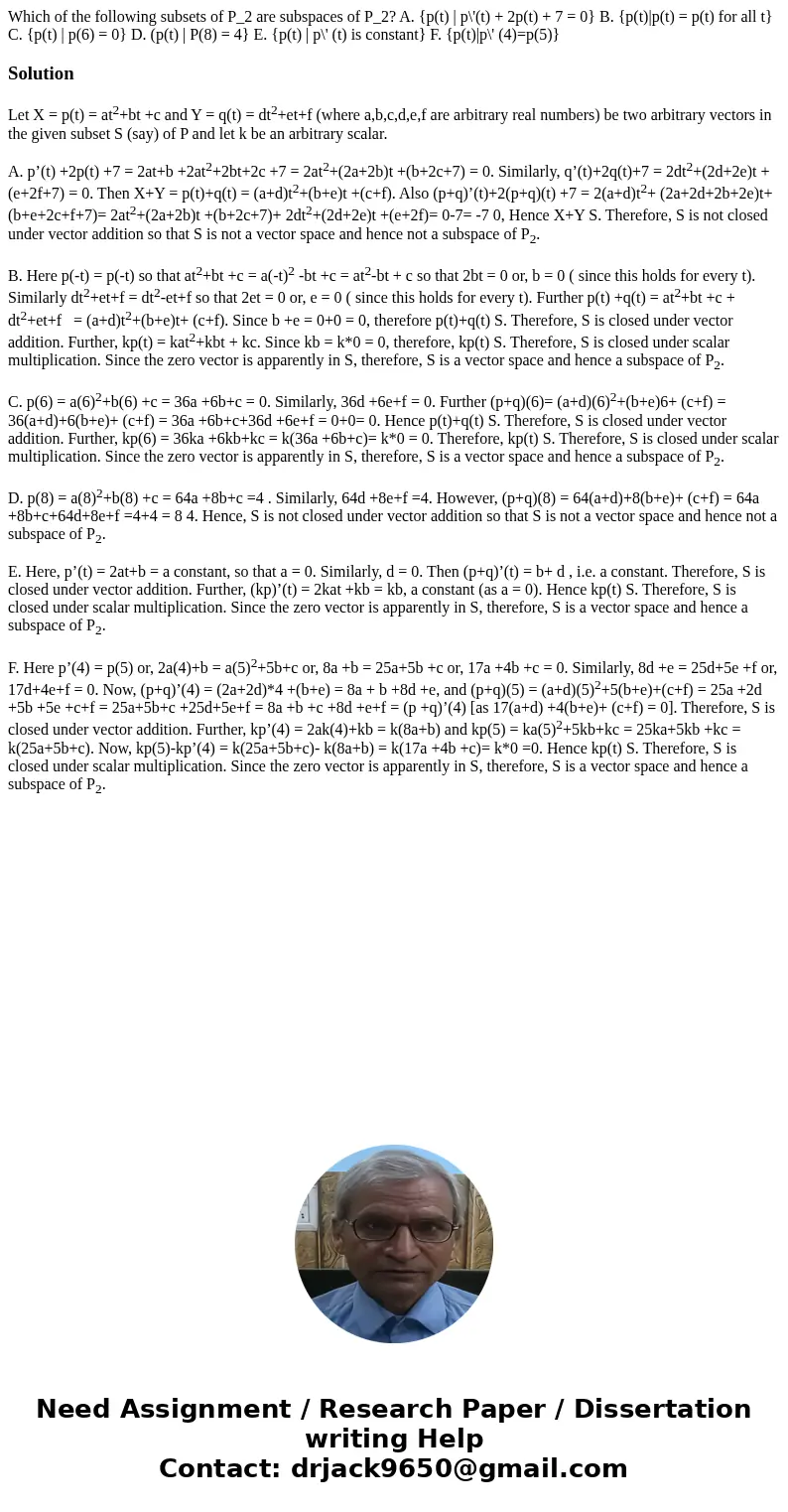Which of the following subsets of P2 are subspaces of P2 A p
Solution
Let X = p(t) = at2+bt +c and Y = q(t) = dt2+et+f (where a,b,c,d,e,f are arbitrary real numbers) be two arbitrary vectors in the given subset S (say) of P and let k be an arbitrary scalar.
A. p’(t) +2p(t) +7 = 2at+b +2at2+2bt+2c +7 = 2at2+(2a+2b)t +(b+2c+7) = 0. Similarly, q’(t)+2q(t)+7 = 2dt2+(2d+2e)t +(e+2f+7) = 0. Then X+Y = p(t)+q(t) = (a+d)t2+(b+e)t +(c+f). Also (p+q)’(t)+2(p+q)(t) +7 = 2(a+d)t2+ (2a+2d+2b+2e)t+(b+e+2c+f+7)= 2at2+(2a+2b)t +(b+2c+7)+ 2dt2+(2d+2e)t +(e+2f)= 0-7= -7 0, Hence X+Y S. Therefore, S is not closed under vector addition so that S is not a vector space and hence not a subspace of P2.
B. Here p(-t) = p(-t) so that at2+bt +c = a(-t)2 -bt +c = at2-bt + c so that 2bt = 0 or, b = 0 ( since this holds for every t). Similarly dt2+et+f = dt2-et+f so that 2et = 0 or, e = 0 ( since this holds for every t). Further p(t) +q(t) = at2+bt +c + dt2+et+f = (a+d)t2+(b+e)t+ (c+f). Since b +e = 0+0 = 0, therefore p(t)+q(t) S. Therefore, S is closed under vector addition. Further, kp(t) = kat2+kbt + kc. Since kb = k*0 = 0, therefore, kp(t) S. Therefore, S is closed under scalar multiplication. Since the zero vector is apparently in S, therefore, S is a vector space and hence a subspace of P2.
C. p(6) = a(6)2+b(6) +c = 36a +6b+c = 0. Similarly, 36d +6e+f = 0. Further (p+q)(6)= (a+d)(6)2+(b+e)6+ (c+f) = 36(a+d)+6(b+e)+ (c+f) = 36a +6b+c+36d +6e+f = 0+0= 0. Hence p(t)+q(t) S. Therefore, S is closed under vector addition. Further, kp(6) = 36ka +6kb+kc = k(36a +6b+c)= k*0 = 0. Therefore, kp(t) S. Therefore, S is closed under scalar multiplication. Since the zero vector is apparently in S, therefore, S is a vector space and hence a subspace of P2.
D. p(8) = a(8)2+b(8) +c = 64a +8b+c =4 . Similarly, 64d +8e+f =4. However, (p+q)(8) = 64(a+d)+8(b+e)+ (c+f) = 64a +8b+c+64d+8e+f =4+4 = 8 4. Hence, S is not closed under vector addition so that S is not a vector space and hence not a subspace of P2.
E. Here, p’(t) = 2at+b = a constant, so that a = 0. Similarly, d = 0. Then (p+q)’(t) = b+ d , i.e. a constant. Therefore, S is closed under vector addition. Further, (kp)’(t) = 2kat +kb = kb, a constant (as a = 0). Hence kp(t) S. Therefore, S is closed under scalar multiplication. Since the zero vector is apparently in S, therefore, S is a vector space and hence a subspace of P2.
F. Here p’(4) = p(5) or, 2a(4)+b = a(5)2+5b+c or, 8a +b = 25a+5b +c or, 17a +4b +c = 0. Similarly, 8d +e = 25d+5e +f or, 17d+4e+f = 0. Now, (p+q)’(4) = (2a+2d)*4 +(b+e) = 8a + b +8d +e, and (p+q)(5) = (a+d)(5)2+5(b+e)+(c+f) = 25a +2d +5b +5e +c+f = 25a+5b+c +25d+5e+f = 8a +b +c +8d +e+f = (p +q)’(4) [as 17(a+d) +4(b+e)+ (c+f) = 0]. Therefore, S is closed under vector addition. Further, kp’(4) = 2ak(4)+kb = k(8a+b) and kp(5) = ka(5)2+5kb+kc = 25ka+5kb +kc = k(25a+5b+c). Now, kp(5)-kp’(4) = k(25a+5b+c)- k(8a+b) = k(17a +4b +c)= k*0 =0. Hence kp(t) S. Therefore, S is closed under scalar multiplication. Since the zero vector is apparently in S, therefore, S is a vector space and hence a subspace of P2.

 Homework Sourse
Homework Sourse